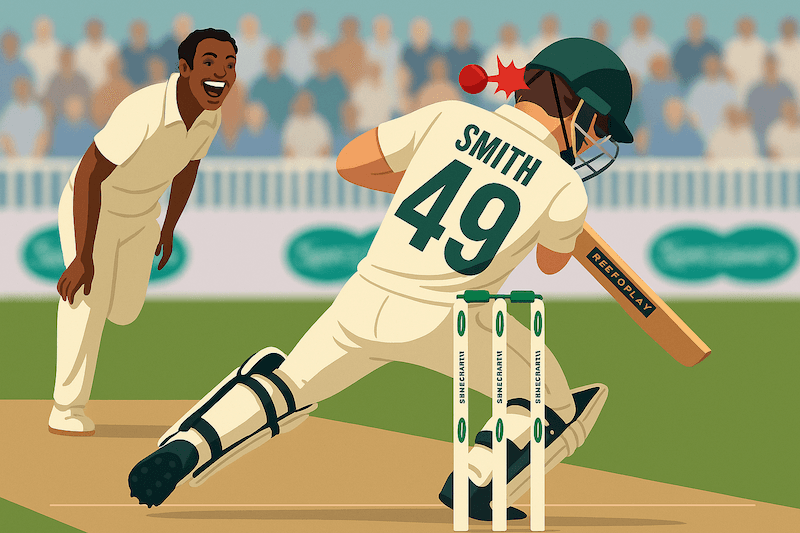
Ever wondered why fielders crowd the circle at the start of an ODI or T20, and then suddenly drift back to the ropes?
That’s the Powerplay in action.
It’s not just a rule; it’s a battle of risk and reward that defines the tempo of modern white-ball cricket. Let’s find out how it works.
What is a Powerplay?
- A Powerplay is a set period in limited-overs cricket when fielding restrictions are applied.
- These restrictions decide how many fielders are allowed outside the 30-yard circle.
- Powerplays make the game more exciting, giving batters a chance to score quickly and bowlers a test of skill and strategy.
Powerplays in ODIs
ODI cricket (50 overs per side) has three Powerplays:
- First Powerplay (Overs 1–10)
- Only two fielders are allowed outside the 30-yard circle.
- Usually, teams attack here, with openers playing aggressive shots to make use of fewer boundary fielders.
- Second Powerplay (Overs 11–40)
- Up to four fielders can stay outside the circle.
- This is the “middle overs” phase, where teams rotate strike, build partnerships, and bowlers focus on control.
- Third Powerplay (Overs 41–50)
- Now, five fielders can be placed outside the circle.
- It’s the death overs, where big hits, yorkers, slower balls, and all-out tactics come into play to finish strong.
Powerplays in T20 Cricket
- T20s (20 overs per side) are shorter, so there’s only one Powerplay — the first 6 overs.
- During this time, only two fielders can be outside the circle.
- Teams aim for fast starts here, and scoring between 40 and 60 runs in the Powerplay is considered excellent.
- Bowlers try to use swing, variation, and accuracy to get early wickets before the field spreads out.
- Post Powerplay, a team can have up to five fielders outside the 30-yard circle.
Explore More Stories

2005 Ashes: The Summer Cricket Became Theatre
The 2005 Ashes was more than just a cricket series. It was a rollercoaster of emotion, courage, and unforgettable moments that brought Test cricket back to life. England’s long wait finally ended, and the world watched history unfold.

What Happened to Zimbabwe Cricket? The Rise, Fall, and Fight for Survival
Once they challenged the world’s best, now they struggle to stay afloat. Zimbabwe cricket’s journey from the glory of 1999 to years of chaos and heartbreak is a story of politics, power, and lost pride, and of a nation still dreaming of revival.
Why Powerplays Matter
- For Batters: It’s the best time to attack. With fewer fielders outside the circle, boundaries come easier. But playing too aggressively can be risky — one misjudged shot can still lead to a wicket.
- For Bowlers: It’s a real test of skill. With less protection in the deep, bowlers must bowl smart lines, use swing, and change their pace to stop attacking batters and take early wickets.
- For Captains: It’s a test of tactics. They need to set smart fields, choose the right bowlers, and sometimes even bring in a spinner early to break the batters’ rhythm. Handling pressure during these overs can shape the rest of the innings.
Common Strategies During Powerplays
- The Batting team must balance the risk of losing early wickets with the reward of scoring quickly. A fast start can build confidence, but early aggression can also lead to quick dismissals.
- The approach depends on the pitch. On flat tracks, batters look to attack from the start, while on seaming or swinging pitches, they begin more carefully to protect wickets.
- Bowlers aim to hit a tight line and length, using movement to stop boundaries and create pressure for early wickets.
- Modern batters play creative shots like scoops and reverse sweeps to find gaps and beat the field restrictions.
- Early momentum is crucial. A strong Powerplay can set the tone for the innings, while a poor one can leave the team struggling to recover.
Special Cases: Slow Over Rate Penalty
- In T20s, if the fielding team fails to start the final over on time, they lose one fielder from outside the 30-yard circle and can have only four for the rest of the innings.
- In ODIs, for each over the team falls short at the scheduled finish time, one extra fielder must stay inside the circle. For example, if they are two overs behind, the last two overs are bowled with only four fielders outside the circle.
- The penalty applies if the fielding team is behind the required over rate at the scheduled finish time, after fair delays like injuries or reviews are taken into account.
- Having one fewer fielder on the boundary can make a big difference in the final overs, as it becomes easier for batters to hit boundaries and shift the momentum.
The Bigger Picture
Powerplays shape the rhythm of every limited-overs game. They turn ordinary overs into moments of high tension, where strategy, skill, and timing decide everything.





